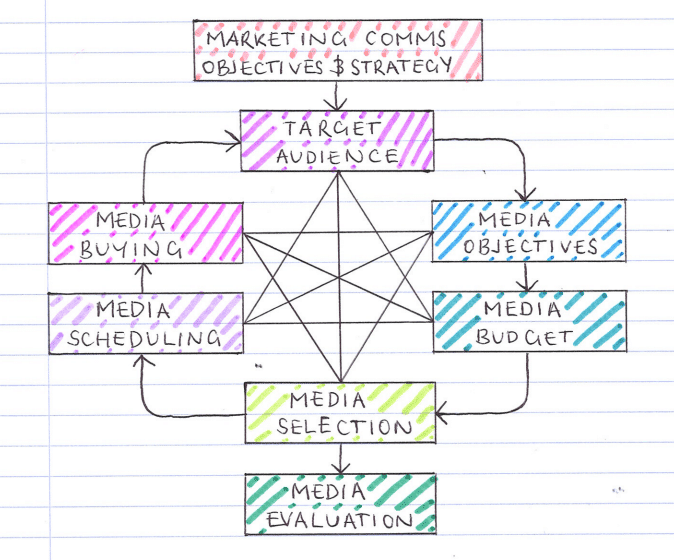This week’s lecture notes will look at how the media implementation cycle fits into marketing communication planning, and how we might measure effectiveness across multiple channels.
Media implementation cycle
Before diving into the media implementation cycle, we must first look at the different types of media available. Using media will support communication planning, as it allows you to consistently promote company messaging through channels that your prospects are using daily.
The three key media categories are:
- Bought media: Adverts, Sponsorship, Pay Per Click (PPC)
- Owned media: Websites, LinkedIn articles, Blogging
- Earned media: Press Coverage, Viral and Social media
Media implementation strategy needs to be planned systematically. Pickton & Broderick (2005) developed the media implementation cycle to be used as a planning framework for media activities. The media implementation cycle features coherent activities including media strategy planning, scheduling, target audience, and media selection, right through to media evaluation at the end.
How do we use the media implementation cycle?
- Marketing communications objectives and strategy: This is the first step in the framework, and it means that your objectives and strategy need to be set ahead of planning media implementation. For definitions on objectives and strategy please see my last blog.
- Target audience: Your target audience/ audiences are the people that you intend to reach with your media marketing communication messages.
- Media objectives: In this section, you should outline what you plan to achieve in terms of media reach, the frequency of activities, and the impact of messages.
- Media budget: The budget of the media plan will vary depending on company size, but any budgets should be relative to the objectives you plan to achieve and segmented by each platform to give better analysis of financial resources for each activity.
- Media selection: These are the range of media channels you plan to use to communicate company messaging to your target audience.
- Media scheduling: The process of planning the frequency of advertising, and when you plan to place your ads.
- Media buying: Speaking with publications to seek the best advertising rates or the process of purchasing other media promotion methods.
- Media evaluation: The assessment of how well your media advertising performed, you may wish to evaluate advertising based on click-through rates or uplift in sales.
Many of these steps within this media planning framework concern the reach, frequency, and impact of messages communicated to the audience.
How do we measure the effectiveness of different communications?
Using a variety of channels really brings a bundle of benefits. However, measuring all these channels alongside each other can prove difficult as each channel will have a slightly different way of analysing metrics. For example, when reviewing advertising stats, you could be looking at click-through rates and impressions. When reviewing a contributed article that you have earned, there’s simply no metrics you can pull out from it except the number of people the magazine was sent to. Even when taking the circulation figure, that doesn’t really tell you the actual number of people that read or even acted (such as visited the company website to find out more information) from reading the article. The challenge is real.
Seeing an uplift in sales is one of the most used methods for measuring the success of campaigns. It doesn’t provide granular detail on what assets were performing best but it does provide you with real stats that indicate how well your overall marketing is doing. Another key indicator is the number of direct responses your company is receiving from new prospects such as incoming calls, redeemed vouchers, and higher email open rates. It is important to factor in that the results for some of your marketing communication plans will be long term, such as brand building. While some of the media advertisement may bring direct short-term business such as sales.

